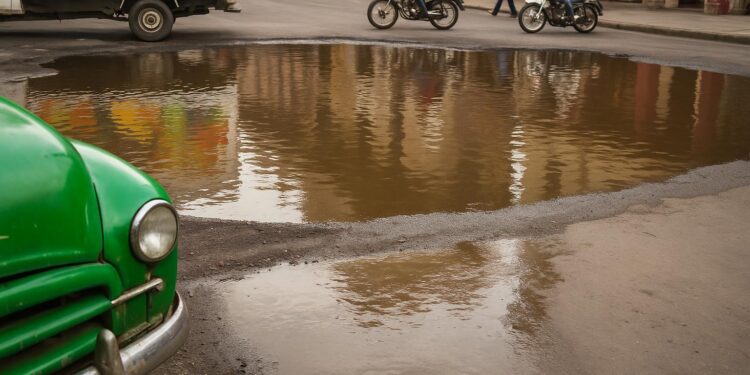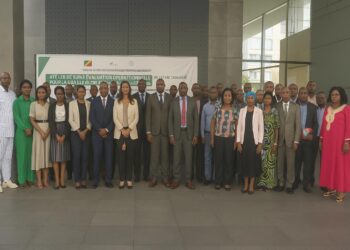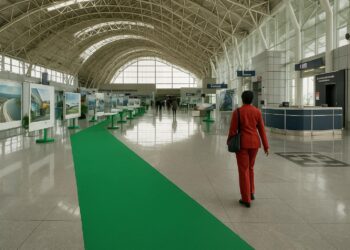Strategic link between Ngamakosso and Talangaï
This second northern exit of Brazzaville, skirting Ngamakosso before fanning into Talangaï, was conceived as a pressure valve for the capital’s dense traffic. Less than a year after spot rehabilitation near the Blaise Adoua bus stop, cracks and potholes retake control.
At the milestone called “Église”, wheel-wide cavities puncture the surface, forcing taxis to terminate journeys abruptly. Commuters disembark, cross muddy verges on foot, and bargain for onward rides on the opposite carriageway, stretching a nominal ten-minute trip into a tiring relay.
Drivers of the north-south trucking corridor, wary of axle damage, divert toward already saturated downtown arteries. Their detours dilute the original objective of easing commercial flow from Oyo and Ouésso, two timber and agro-logistic hubs feeding Brazzaville’s wholesale markets.
Residents and drivers count the economic toll
For residents, the daily inconvenience quickly translates into cost. Taxi operators either refuse the segment or introduce a so-called “half-terrain” surcharge, fracturing what used to be a 300-CFA fare into two hops that can reach 500 CFA each during peak rain.
Sixteen-year-old Adrien, uniform still damp, recounts leaving home before sunrise to secure a seat beyond the impassable stretch. His testimony echoes that of mothers escorting young children across puddles, fearing the unpredictable weave of motorbikes, minibuses and heavy trucks.
Informal measurements by local associations suggest pedestrian crossing time has doubled since the first rains of October. A simple commute that once averaged twelve minutes now requires almost twenty-five, eroding classroom attendance rates and adding labour-hour losses for informal traders.
A back-of-the-envelope estimate featured in a civic forum last week values the hidden cost at nearly 60 million CFA francs per quarter, counting extra fuel, spare parts and missed appointments. Such figures underscore why rapid maintenance is more than cosmetic.
A race against tropical rainfall
Engineers attribute the premature degradation to a cocktail of inadequate drainage, axle loads exceeding design assumptions, and the region’s high-plasticity soils that swell in heavy rain before cracking in the dry season. Without continuous sealing, each storm widens existing fissures.
The most recent resurfacing, limited to a one-kilometre patch, relied on interlocking pavers prized for aesthetic value but vulnerable if edge pieces dislodge. Observers note missing pavers near Claudia junction, allowing water to undermine the granular base within weeks.
Rain intensity data from the National Meteorological Agency show Talangaï received 18 percent more precipitation this October than the decade’s average. Such spikes compress the maintenance window and complicate asphalt procurement schedules that depend on imported bitumen delivered through Pointe-Noire.
Maintenance funding and procurement outlook
Budget lines for urban roads are centrally managed, yet municipalities often initiate rapid-response works through delegated credits. Talangaï officials indicate that their envelope for 2023 barely covers routine sweeping, leaving structural repairs to the Road Maintenance Fund and donor programmes.
Public-private partnership law, updated in 2021, theoretically allows concessionaires to recoup investment via tolls or advertising rights. However, the modest traffic counts on the Ngamakosso branch may not meet viability thresholds, making a traditional public contract the most plausible path.
In the interim, community groups have proposed crowd-funded patching weekends, echoing earlier initiatives in Djiri. Engineers caution that ad-hoc cold mix often fails within months, yet agree it buys time for procurement cycles to mature and rains to subside.
City councillors also discuss an interim traffic management plan. Possible measures include rerouting articulated trucks to the parallel Marien Ngouabi Avenue during peak showers, combined with enforcement of axle-load checks at the Claudia bottleneck, a move expected to extend pavement life.
Potential impact on northern logistics flows
Strategically, the second northern exit forms part of National Road 2’s urban approach, funnelling goods from the Cuvette and Sangha departments to the port district. Any prolonged closure could reverberate through timber exports and the budding cassava value chain.
Historical traffic counts compiled by the Ministry of Transport place average daily flow at three thousand light vehicles and four hundred trucks. While below Pointe-Noire standards, this volume is sufficient to influence wholesale price stability for fish, cement and fuel.
Local chambers of commerce caution that uncertainty over haulage times inflates working capital needs. Traders must now hold two days of extra stock, tying up liquidity that could finance modernization of cold storage or micro-credit to rural suppliers.
Government spokespeople reiterate that maintaining urban arteries remains a priority embedded in the 2022-2026 National Development Plan. Officials emphasise that recent bottlenecks are temporary and that technical teams are finalising scope studies before deploying contractors once weather conditions stabilise.
Until then, the second northern exit will continue to multitask as a classroom, marketplace and negotiating table, illustrating how infrastructure health intersects with social and commercial well-being. Repairs may be costly, yet the price of inaction grows with every rainfall.












































